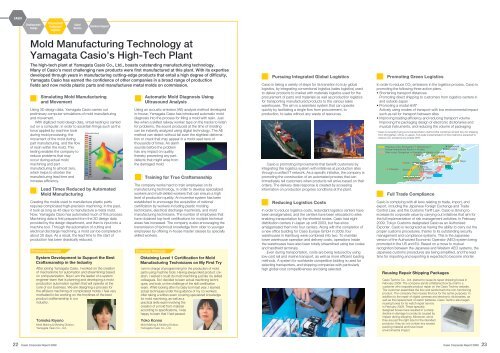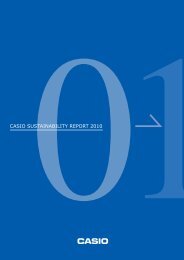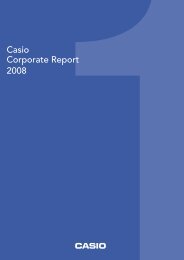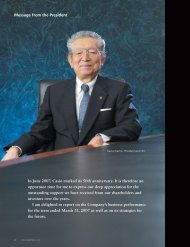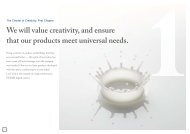Casio Computer Co. Ltd
Corporate Report 2009 all pages - Casio
Corporate Report 2009 all pages - Casio
- No tags were found...
You also want an ePaper? Increase the reach of your titles
YUMPU automatically turns print PDFs into web optimized ePapers that Google loves.
CASIO<br />
Development/<br />
Design<br />
Procurement/<br />
Production/<br />
Logistics<br />
Sales/<br />
Service<br />
Business Support<br />
Mold Manufacturing Technology at<br />
Yamagata <strong>Casio</strong>’s High-Tech Plant<br />
The high-tech plant at Yamagata <strong>Casio</strong> <strong>Co</strong>., <strong>Ltd</strong>., boasts outstanding manufacturing technology.<br />
Many of <strong>Casio</strong>’s most challenging new products were first manufactured at this plant. With its expertise<br />
developed through years in manufacturing cutting-edge products that entail a high degree of difficulty,<br />
Yamagata <strong>Casio</strong> has earned the confidence of other companies in a broad range of production<br />
fields and now molds plastic parts and manufactures metal molds on commission.<br />
Simulating Mold Manufacturing<br />
and Movement<br />
Using 3D design data, Yamagata <strong>Casio</strong> carries out<br />
preliminary computer simulations of mold manufacturing<br />
and movement.<br />
With digitized mold design data, virtual testing is carried<br />
out on a computer, in order to ascertain things such as the<br />
force applied by machine tools<br />
Filling pattern [sec.]<br />
during mold processing, the<br />
movement of the mold during<br />
part manufacturing, and the flow<br />
of resin within the mold. This<br />
testing enables the company to<br />
reduce problems that may<br />
occur during actual mold<br />
machining and part<br />
manufacturing to almost zero,<br />
which helps to shorten the<br />
manufacturing lead time and<br />
increase efficiency.<br />
Lead Times Reduced by Automated<br />
Mold Manufacturing<br />
Creating the molds used to manufacture plastic parts<br />
requires complicated high-precision machining. In the past,<br />
it took as long as 45 days to manufacture a metal mold.<br />
Now, Yamagata <strong>Casio</strong> has automated much of this process.<br />
Machining data is first prepared from the 3D design data<br />
provided by the design department, and then is input into a<br />
machine tool. Through the automation of cutting and<br />
electrical discharge machining, a mold can be completed in<br />
about 20 days. As a result, the lead time to the start of<br />
production has been drastically reduced.<br />
Employee Message<br />
System Development to Support the Best<br />
Craftsmanship in the Industry<br />
After joining Yamagata <strong>Casio</strong>, I worked on the creation<br />
of mechanisms for automation and streamlining based<br />
on computerization. Now I am the leader of a system<br />
engineer team that is planning and developing a mold<br />
production automation system that will operate at the<br />
core of our business. We are designing a process for<br />
the efficient machining of complicated molds. I feel very<br />
motivated to be working on the frontlines of the best<br />
product craftsmanship in our<br />
industry.<br />
Tomoka Kiyono<br />
Mold Making & Molding Division,<br />
Yamagata <strong>Casio</strong> <strong>Co</strong>., <strong>Ltd</strong>.<br />
Automatic Mold Diagnosis Using<br />
Ultrasound Analysis<br />
Using an acoustic emission (AE) analysis method developed<br />
in-house, Yamagata <strong>Casio</strong> has introduced automatic mold<br />
diagnosis into the process for filling a mold with resin. Just<br />
like when a skilled railway worker taps on the tracks to listen<br />
for problems, the sound produced at the time of molding<br />
can be instantly analyzed using digital technology. The AE<br />
method can detect without fail even the slightest deformation<br />
or crack that may appear in a mold used tens of<br />
thousands of times. An alarm<br />
sounds before the problem<br />
has any impact on quality,<br />
thereby preventing any part<br />
defects that might arise from<br />
the damaged mold.<br />
Training for True Craftsmanship<br />
The company works hard to train employees on its<br />
manufacturing technology, in order to develop specialized<br />
workers and multi-skilled workers that can ensure a high<br />
level of production quality. An incentive system has been<br />
established to encourage the acquisition of national<br />
certification by workers including plastic molding<br />
technicians, electrical discharge machinists, and mold<br />
manufacturing technicians. The number of employees that<br />
have obtained top-level certifications for multiple technical<br />
areas has increased. The company is also encouraging the<br />
transmission of technical knowledge from older to younger<br />
employees by offering in-house master classes by specially<br />
skilled workers.<br />
Employee Message<br />
Obtaining Level 1 Certification for Mold<br />
Manufacturing Technicians on My First Try<br />
I am in charge of programming for the production of mold<br />
parts using machine tools. Having always liked product creation,<br />
I wished I could do mold machining just like my skilled<br />
colleagues. So I decided to learn actual machining techniques,<br />
and took on the challenge of the skill certification<br />
exam. While looking after my baby born last year, I learned<br />
actual techniques under the guidance of my co-workers.<br />
After taking a written exam covering specialized knowledge<br />
for mold machining, as well as a<br />
practical skills exam involving the<br />
creation of a mold from material<br />
according to specifications, I was<br />
happy to learn that I had passed.<br />
Yoko Konno<br />
Mold Making & Molding Division,<br />
Yamagata <strong>Casio</strong> <strong>Co</strong>., <strong>Ltd</strong>.<br />
Pursuing Integrated Global Logistics<br />
<strong>Casio</strong> is taking a variety of steps for its transition to truly global<br />
logistics, by integrating conventional logistics (sales logistics) used<br />
to deliver products to market with materials logistics used for the<br />
procurement of parts and materials as well as production logistics<br />
for transporting manufactured products to the various sales<br />
warehouses. The aim is a seamless system that can operate<br />
quickly by facilitating a single flow from procurement, to<br />
production, to sales without any waste of resources.<br />
<strong>Casio</strong> is promoting improvements that benefit customers by<br />
integrating this logistics system with initiatives at production sites<br />
through a unified IT network. As a specific initiative, the company is<br />
promoting the construction of an automated process that can<br />
immediately tell customers when products will arrive based on their<br />
orders. The delivery date response is created by accessing<br />
information on production progress conditions at the plant.<br />
Reducing Logistics <strong>Co</strong>sts<br />
In order to reduce logistics costs, redundant logistics centers have<br />
been amalgamated, and the centers have been relocated to sites<br />
enabling transportation by the shortest routes. <strong>Casio</strong> had eight<br />
distribution centers in Japan up until 2003, but has since<br />
amalgamated them into four centers. Along with the completion of<br />
a new office building for <strong>Casio</strong> Europe GmbH in 2009, four<br />
warehouses in Hamburg were combined into two. To maintain<br />
lower warehouse operation and delivery costs, operations inside<br />
the warehouses have also been totally streamlined using bar codes<br />
and handheld terminals.<br />
Even during transportation, costs are being reduced by using<br />
low-cost rail and marine transport, as well as more efficient loading<br />
methods. A system for worldwide competitive bidding is used for<br />
selecting transporters, and shipping companies with particularly<br />
high global cost competitiveness are being selected.<br />
Promoting Green Logistics<br />
In order to reduce CO 2 emissions in the logistics process, <strong>Casio</strong> is<br />
promoting the following three action plans.<br />
• Shortening transport distances<br />
Promoting direct shipping to customers from logistics centers in<br />
and outside Japan<br />
• Promoting a modal shift*<br />
Actively using modes of transport with low environmental impact<br />
such as rail for transport between sites<br />
• Improving loading efficiency and reducing transport volume<br />
Improving the packaging design of electronic dictionaries and<br />
musical instruments, and reducing the volume of packaging<br />
* <strong>Casio</strong> is currently trying out a transportation method that combines rail and ferry for shipping<br />
from Zhongshan, China, to Japan. Full-scale implementation of this method is expected to<br />
reduce CO2 emissions by at least 95%.<br />
Previous route: Zhongshan ➞ Hong Kong ➞<br />
Kansai International Airport ➞ Suzuka<br />
● Habarovsk<br />
● Vladivostok<br />
New route: Zhongshan ➞ Shanghai ➞ Hakata ➞ Suzuka<br />
● Beijing ● Pyongyang<br />
● Xi’an<br />
● Seoul<br />
● Pusan ● Tokyo<br />
● Nanjing<br />
● Chengdu Wuhan ● ● Hangzhou<br />
● Shanghai<br />
● Taipei<br />
● Hong Kong<br />
Full Trade <strong>Co</strong>mpliance<br />
<strong>Casio</strong> is complying with all laws relating to trade, import, and<br />
export, including the Japanese Foreign Exchange and Trade<br />
<strong>Co</strong>ntrol Law, and the Customs Tariff Law. <strong>Casio</strong> is striving to<br />
increase its corporate value by carrying out initiatives that aim for<br />
the full implementation of risk management activities. In February<br />
2009, Tokyo Customs designated <strong>Casio</strong> as an Authorized<br />
Exporter. <strong>Casio</strong> is recognized as having the ability to carry out the<br />
proper customs procedures, thanks to its outstanding security<br />
management and compliance systems. This is the Japanese<br />
version of the Authorized Economic Operator (AEO) system being<br />
promoted in the US and EU. Based on a move to mutual<br />
recognition between the Japanese and Western AEO systems, the<br />
Japanese customs procedures are being simplified, and the lead<br />
time for importing and exporting is expected to become shorter.<br />
Reusing Repair Shipping Packages<br />
<strong>Casio</strong> Techno <strong>Co</strong>., <strong>Ltd</strong>. started to reuse its repair shipping boxes in<br />
February 2008. The company sends a flattened box by mail to a<br />
customer who requests product repair on the <strong>Casio</strong> Techno website.<br />
The customer assembles the box and sends back the non-functioning<br />
product. The company then reuses the box for the same purposes. In<br />
addition to the repair of digital cameras and electronic dictionaries, as<br />
well as the replacement of watch batteries, <strong>Casio</strong> Techno also began<br />
reusing boxes for its watch repair service<br />
in February 2009. These specially<br />
designed boxes have resulted in a sharp<br />
decline in damage to products caused by<br />
impact during shipping. Moreover, since<br />
they are just the right size for the intended<br />
products, they do not contain any excess<br />
packing material and have lower<br />
environmental impact.<br />
22 <strong>Casio</strong> <strong>Co</strong>rporate Report 2009 <strong>Casio</strong> <strong>Co</strong>rporate Report 2009 23


